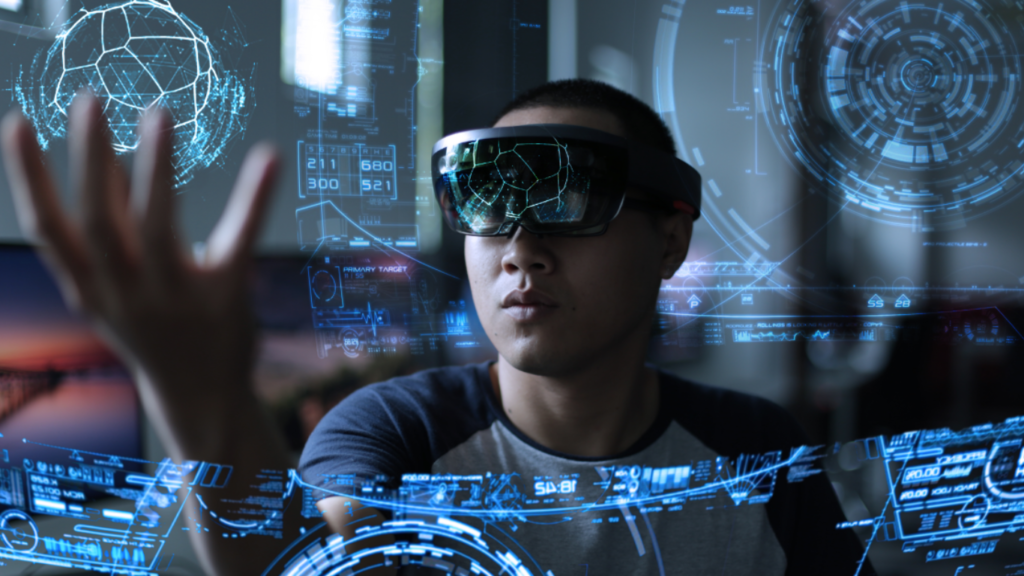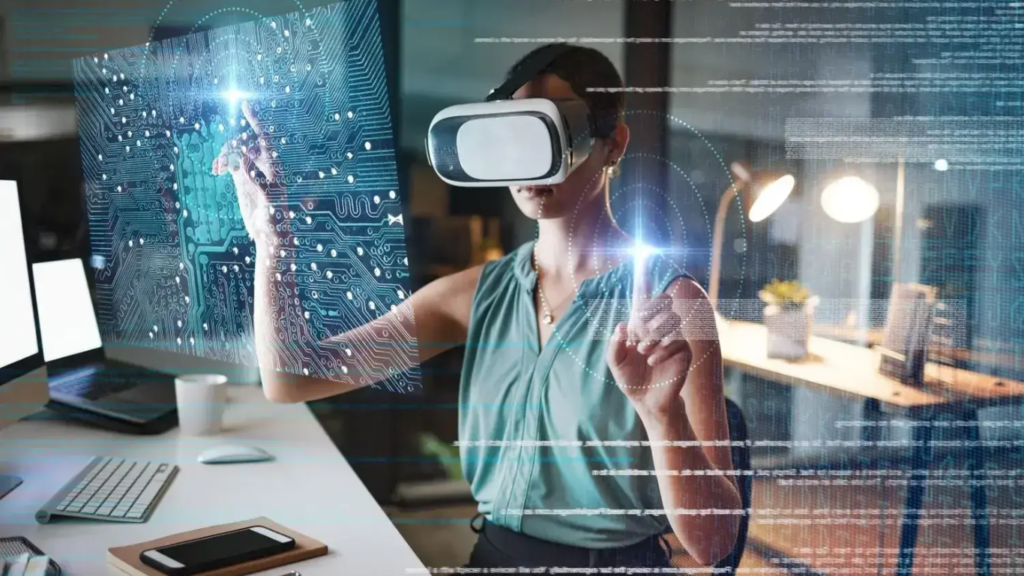The world around us is no longer physical,it’s one the verge of becoming digital and interactive. From AR (augmented reality) to VR (virtual reality) headset,technology is blending with reality,we have seen only in Hollywood movies.
Spatial Computing or Sc melds with physical and digital technology through AR,VR.
Table of Contents
What Is Spatial Computing?
Spatial computing refers to the blending of the physical and digital world in a way that allows us to interact with data more efficiently.
In a simple way, a digital layer that sits on the top of the physical reality.powered by tools like AR,VR and AI and so on.Instead of using buttons,Spatial computing allows us to use gestures,voice, eye movement to connect with technology.think of AR glasses which allows you to see directions of the road as you walk,or VR which lets you operate heart surgery in 3D before entering a real operation room.

How Spatial Computing Works
Sensors & Cameras
Artificial Intelligence (AI)
Augmented Reality (AR)
Virtual Reality (VR)
Internet of Things (IoT)
For Example:
When you wear an AR headset,it maps your room,identifies furniture position and allows you to choose the ideal place for your virtual TV on your wall.
In the healthcare sector, doctors can use VR to perform 3d heart operations before going for a real one.
Everyday Examples of Spatial Computing
- Pokemon Go.
- Apple Vision Pro / Meta Quest headsets
- Google Maps Live View
- Smart Homes
- Industrial Training Simulators.
Applications of Spatial Computing Across Industries
1 Education
- Students can study by wearing VR.
- Medical students can practice 3d surgeries before going for a real one.
2 Healthcare
- Surgeons use AR to visualize organs in 3D before cutting a real one.
- Therapy uses VR for treating anxiety, and phobias.
3 Business & Work
- Remote meetings happen in virtual 3D offices.
- Employees meet up on 3D models.
4 Entertainment
- Immersive video games with AR/VR.
Impact of Spatial Computing on Society
Positive Impacts
- Improved Learning & Training
- Healthcare Advancements
- Accessibility
- Productivity
Challenges & Concerns
- Privacy Issues
- Digital Divide.
- Addiction & Overreliance
Future of Spatial Computing
The future of Spatial computing is about how humans interact with technology and it is being seen as a long shot after the rise of smart phones and screens.envisage a place where you enter a workplace where global colleagues are sitting next to you as a hologram.This is what promise Spatial computing does to you.Tech companies like Apple,Google,Meta are already investing.In healthcare industry the future of spatial computing can save lives by performing intricate surgeries in real time.in education,classrooms will not longer be limited by four walls.Students could travel any city virtually,Operate any digital organism.Spatial computing is simply the next step towards smart world.The spatial computing is not just about gadgets and headsets but also where true potential of human will come into existence.
Conclusion
It’s the blend of physical and digital worlds by using AR, VR, AI, and IoT. According to the spatial computing definition, it helps humans connect with technology.
From education and healthcare to business and entertainment, spatial computing is reshaping society—making life easier, smarter, and more efficient.
FAQs
What is spatial computing?
Spatial computing is the technology that blends the physical and digital worlds using tools like AR, VR, AI, and IoT. It allows people to interact with digital information in real-world spaces through gestures, voice, or movement.
Why is spatial computing considered the future of technology?
Because it removes the barrier of screens and keyboards, making technology more natural and immersive. Instead of adapting to devices, devices adapt to human behavior and environments.
How will spatial computing change daily life?
It will make interactions seamless—like AR glasses replacing smartphones, homes responding to gestures, or holographic meetings with people worldwide. Everyday tasks will become faster and more intuitive.
What industries will benefit the most from spatial computing?
Healthcare, education, entertainment, business, and smart cities are expected to see the biggest transformations, with applications in surgery, virtual learning, immersive gaming, and autonomous vehicles.
Will spatial computing replace smartphones in the future?
Many experts believe that AR glasses and wearable devices powered by spatial computing could eventually replace smartphones as our primary digital interface.
What challenges does spatial computing face?
Major challenges include privacy concerns (due to constant environmental tracking), high device costs, digital inequality, and the need for strong regulations.
How does spatial computing work with AI?
AI helps spatial computing analyze data, understand context, and provide real-time, personalized experiences—like projecting a 3D assistant into your living room.
Is spatial computing safe for users?
Yes, but it depends on how data is managed. Companies must ensure strong security measures and transparency to protect users’ privacy.
When will spatial computing become common?
Experts predict that by the late 2030s, spatial computing devices like AR glasses and VR systems may become as common and affordable as smartphones today.
How can society prepare for the future of spatial computing?
By adopting responsible usage, encouraging digital literacy, building fair access to devices, and implementing regulations to protect privacy while still enabling innovation.


